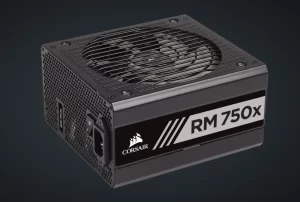The Corsair RM750X power supply is globally compatible and can function across different regions. It features a wide input voltage range (100-240V), making it capable of operation in the United States (typically 120V) and Europe (typically 230V). However, you may need to acquire a power cord suitable for European outlets, as the type and shape of power cords can vary by region.
Compatibility of the Corsair RM750X

The key to the RM750X’s world-friendly persona is its wide input voltage range. It’s built to handle anything between 100V and 240V. This means whether you’re plugging it into a standard 120V outlet in the United States or a 230V outlet common across Europe, this PSU is ready to roll. You don’t need any transformer or converter – the RM750X is designed to automatically adjust to the input voltage.
And this isn’t just a boon for the globetrotting gamers among us. Even if you never leave your home country, this flexibility can be a lifesaver in areas prone to voltage fluctuations. Your PC hardware is a big investment, and with the RM750X, Corsair ensures that it’s protected, regardless of the voltage in your area. More details about the RM750X’s voltage specifications can be found on the Corsair’s official product page.
You may also like: Is it Safe to Use EVGA PCIe Cables with a Corsair Power Supply?
Differences between Corsair RM750X US model and European model
While the Corsair RM750X power supply unit doesn’t mind what voltage it gets fed, it does need to interface with different power outlets. That’s where power cord types and shapes come into play.
An Array of Plugs
The world is a diverse place, and this diversity extends to something as everyday as power outlets. In North America, for instance, the Type A and B sockets are commonly used, while in Europe, you’re more likely to encounter Type C, E, or F. Each of these plug types has a distinct shape and pin configuration, which are designed to fit into their respective outlets.
If you’ve purchased your RM750X in the United States and later moved to Europe, you might find that the power cord that came with your PSU doesn’t fit into the outlets at your new location.
Finding the Right Cord
But no worries! This doesn’t mean you’ll have to ditch your RM750X or invest in a costly power transformer. All you need is a new power cord that has the correct plug shape for your region on one end, and a standard three-prong IEC C13 connector to fit into the PSU on the other. This type of power cord is common and can be easily purchased from local electronics stores or online platforms like Amazon.
You may also like: Is it Possible to Connect a Corsair Fan to My PC Without a Corsair Hub?
Frequently Asked Questions
What is the Input Voltage of CORSAIR RM750x?
The CORSAIR RM750x power supply, like many of Corsair’s other high-quality PSUs, is equipped with active power factor correction (Active PFC) and is designed for a full range input. This typically means it can operate on input voltages ranging from 100V to 240V, making it compatible with most power grid standards worldwide.
Are Corsair Power Supplies Dual Voltage?
Most Corsair power supplies, especially those designed for the consumer desktop market, are equipped with active power factor correction (Active PFC) and a full range input design. This means they can operate on input voltages typically ranging from 100V to 240V, effectively making them dual voltage. This range covers the vast majority of power grid standards worldwide.
However, the ability to support dual voltage doesn’t mean you can plug a power supply into any socket worldwide without checking. The type of power plug and socket can vary from country to country. Additionally, while the power supply itself can handle the range of voltages, always ensure that the rest of your equipment is compatible with the local power standard if traveling or relocating.
Is CORSAIR RM750x Single Rail?
Yes, the CORSAIR RM750x is a single rail power supply. This means it has one +12V rail that supplies power to all components connected to it. Single rail PSUs provide the entire available amperage on the +12V rail, which can be advantageous for components that demand high power, such as high-end graphics cards. It’s a design choice that’s become common in many modern, high-quality power supplies because of its simplicity and the ease it offers users—they don’t need to balance power loads across multiple rails.

